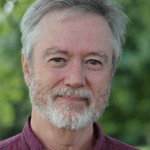Working Forests at Work for Birds
As a youngster, I often went to one of the two woodlots on our small farm to unwind and uproot Japanese honeysuckle. I saw how the exotic invasive wound its way up our dogwoods, distorting and strangling them, and I was determined to eradicate it from our woods. It seemed like rewarding work at the time. (Embarrassing admission: I still do this around the house where I live now.)

Management has now become essential to create habitat for high-priority bird species such as Cerulean Warbler, which requires canopy gaps in mature forest. Photo by Tessa Nickels
Now, more than 50 years later and with a better idea of the world's complexities, I can smile at my early efforts and ideas. But those attempts to manage my little patch of woods were the beginning of an important lesson. I have slowly learned that when it comes to forests, management is necessary. Older is not always better; fire and cutting can often be good; and “leave it alone” and “keep people out” are no longer useful management maxims—for forests and for many habitats.
What I have concluded is this: If we want to maintain our bird diversity, we must recognize and manage for the variety of habitats birds need. And to succeed, we need the help of a wide range of people and organizations.
One of those groups is the Sustainable Forestry Initiative (SFI), which represents one of our newest and most promising partnerships. Almost 270 million acres of forests in North America are certified to the SFI standard, and many SFI participants are forest products companies. Although misunderstood and held at arm's length by some conservationists, they would be fools not to want to work with SFI toward common goals. Frankly speaking, members of the SFI community are often better informed and more supportive of forest and bird needs than some conservationists I work with and value.

Golden-winged Warbler is one of the rapidly declining species that requires forest management to create the early successional habitat on which it depends. Photo by Bill Hubick
Today, humans have so encircled and controlled nature as to prevent it from doing what it does best: manage itself for health and diversity. Due to poor forest stewardship going back more than a century, management has now become essential to create habitat for high-priority bird species that depend on early successional forest, such as Golden-winged Warbler, and other rapidly declining species that need canopy gaps in mature forest, like Cerulean Warbler.
That said, some types of habitat must be off-limits to management. For example, we at ABC continue to press for strong protection of old-growth forests for Northern Spotted Owl and Marbled Murrelet in the Pacific Northwest.
We recognize there are differences of opinion on this matter. However, science clearly shows now that declines among many forest birds can be reversed only through more-active management. Our work with SFI and its program participants is designed specifically to identify ways we can advance bird conservation across millions of acres.
There's a lot of land and a lot of opportunity in this partnership. The future of many much-loved birds in this hemisphere may well depend on our efforts to help forest management companies implement bird conservation across managed forests.
Conservationists, landowners, government, and the private sector all have a shared obligation to deploy what we know about natural cycles and help to accomplish what nature once did on its own. In doing so, we will restore and preserve more habitats. It's one of the most important ways we're “bringing back the birds.”
 George Fenwick is President of American Bird Conservancy. He received a PhD from the Department of Pathobiology at Johns Hopkins University. In 1994, he founded American Bird Conservancy; previously, he had worked for 15 years with The Nature Conservancy as Vice President and Director of Ecosystem Conservation, Acting Director of Science, and Chair of the Steering Committee for the Last Great Places Campaign. Prior to that, he worked for the Chesapeake Bay Foundation, Earthsatellite Corporation, and as an instructor at the University of Virginia.
George Fenwick is President of American Bird Conservancy. He received a PhD from the Department of Pathobiology at Johns Hopkins University. In 1994, he founded American Bird Conservancy; previously, he had worked for 15 years with The Nature Conservancy as Vice President and Director of Ecosystem Conservation, Acting Director of Science, and Chair of the Steering Committee for the Last Great Places Campaign. Prior to that, he worked for the Chesapeake Bay Foundation, Earthsatellite Corporation, and as an instructor at the University of Virginia.


















































